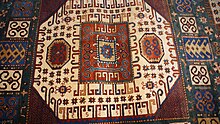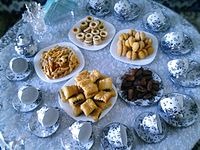
A | B | C | D | E | F | G | H | CH | I | J | K | L | M | N | O | P | Q | R | S | T | U | V | W | X | Y | Z | 0 | 1 | 2 | 3 | 4 | 5 | 6 | 7 | 8 | 9
| Part of a series on |
| Islamic culture |
|---|
| Architecture |
| Art |
| Clothing |
| Holidays |
| Literature |
| Music |
| Theatre |
Eid al-Fitr (/ˌiːd əl ˈfɪtər, -trə/ EED əl FIT-ər, -rə; Arabic: عيد الفطر, romanized: ʿĪd al-Fiṭr, IPA: [ʕiːd al ˈfɪtˤr], lit. 'Holiday of Breaking the Fast'[4]) is the earlier of the two official holidays celebrated within Islam (the other being Eid al-Adha). Eid al-Fitr is celebrated by Muslims worldwide because it marks the end of the month-long dawn-to-sunset fasting of Ramadan.[5] Eid al-Fitr falls on the first day of Shawwal in the Islamic calendar; this does not always fall on the same Gregorian day, as the start of any lunar Hijri month varies based on when the new moon is sighted by local religious authorities. The holiday is known under various other names in different languages and countries around the world. The day is also called "Lesser Eid" (Arabic: العيد الصغير, romanized: al-ʿĪd al-Ṣaghīr), or simply Eid.[6]
Eid al-Fitr has a particular salat (Islamic prayer) that consists of two rakats (units) generally performed in an open field or large hall. It may only be performed in congregation (jamāʿat) and features seven additional Takbirs (raising of the hands to the ears while saying "Allāhu ʾAkbar", meaning "God is the greatest") in the Hanafi school of Sunni Islam: three at the start of the first rakat and three just before rukūʿ in the second rakat.[7] Other Sunni schools usually have 12 Takbirs, similarly split in groups of seven and five. In Shia Islam, the salat has six Takbirs in the first rakat at the end of qira'a, before rukūʿ, and five in the second.[8] Depending on the juristic opinion of the locality, this salat is either farḍ (فرض, obligatory), mustaḥabb (strongly recommended) or mandūb (مندوب, preferable). After the salat, Muslims celebrate the Eid al-Fitr in various ways[9] with food ("Eid cuisine") being a central theme, which also gives the holiday the nickname "Sweet Eid" or "Sugar Feast".[10][11]
History
According to Muslim tradition, Muhammad instituted the celebration of Eid al-Fitr.[12] According to certain ahadith, these festivals were initiated in Medina after the migration of Muhammad from Mecca. Anas ibn Malik, a companion of Muhammad, narrated that when Muhammad arrived in Medina, he found people celebrating two specific days in which they entertained themselves with recreation. Muhammad then remarked that God had fixed two mandatory days of festivity: Eid al-Fitr and Eid al-Adha.[13]
General rituals
Eid al-Fitr begins at sunset on the night of the first sighting of the crescent moon. The night on which the moon is sighted is celebrated as Chand Raat. If the moon is not observed immediately after the 29th day of the previous lunar month (either because clouds block its view or because the western sky is still too bright when the moon sets), then the holiday is celebrated the following day.[14] Eid al-Fitr is celebrated for one to three days, depending on the country.[15] It is forbidden to fast on the Day of Eid, and a specific prayer is nominated for this day.[16] As an obligatory act of charity, money is paid to the poor and the needy (zakat al-Fitr) before performing the 'Eid prayer.[17]
Eid prayer and eidgah
The Eid prayer is performed by the congregation in an open area such as a field, community center, or mosque.[15] No call to prayer is given for this Eid prayer, and it consists of only two rakaʿāt, with a variable amount of takbirs and other prayer elements depending on the branch of Islam observed. The Eid prayer is followed by the khutbah and then a dua asking for God's forgiveness, mercy, peace and blessings for all living beings across the world. The sermon also instructs Muslims as to the performance of rituals of Eid, such as the zakāt.[18] The sermon of Eid takes place after the Eid prayer, unlike Friday prayer which comes first before prayer. Some imams believe that listening to the sermon at Eid is optional.[19] After the prayers, Muslims visit their relatives, friends, and acquaintances or hold large communal celebrations in homes, community centers, or rented halls.[15]

Sunni procedure
As ritual dictates, Sunnis praise God in a loud voice while going to the Eid prayer:
Allāhu Akbar, Allāhu Akbar, Allāhu Akbar. Lā ilāha illà l-Lāh. Allāhu Akbar, Allahu akbar, wa-li-l-Lāh al-ḥamd
Recitation ceases when they get to the place of Eid or once the Imam commences activities.[20]
The prayer starts by doing niyyah "intention" for the prayer before the takbir is said by the imam. Next, the takbir al-ihram is performed, by saying takbir three times, raising hands to the ears and dropping them each time, except for the last when the hands are folded. The Imam then reads al-Fatihah, followed by another surah. The congregation performs ruku and sujud. This completes the first rak'ah.[21]
The congregation rises and folds their hands for the second rak'ah, after which the imam recites al-Fatiha followed by another surah. After this, three takbirs are called out just before the ruku, each time raising hands to the ears and dropping them. For the fourth time, the congregation says Allahu Akbar and subsequently goes into the ruku. The rest of the prayer is completed regularly. This completes the Eid prayer. After the prayer, there is a khutbah.[22]
Shia procedure
The prayer starts with the Niyyat followed by five Takbirs. During every Takbir of the first rakat, a special Dua is recited. Then, the Imam recites Sūrat al-Fātiḥah and Surat Al-'A`lá and the congregation performs Ruku and Sujud as in other prayers. In the second Rakat, the same above steps (five Takbeers, Sūrat al-Fātiḥah and Surat Al-'A`lá, Ruku and Sujud) are repeated. After the prayer, Khutbah starts.[23]
Post-prayer celebration
During the Eid celebration, Muslims greet each other by saying 'Eid Mubarak', which is Arabic for "Blessed Eid". As it comes after a month of fasting, sweet dishes and foods are often prepared and consumed during the celebration. Muslims typically decorate their homes, and are also encouraged to forgive each other and seek forgiveness. In countries with large Muslim populations, it is normally a public holiday with most schools and businesses closed for the day. Practices differ by country and region.[24]
Practices and culture by country
West Asia

Arab States of the Persian Gulf
In the United Arab Emirates and other Arab states of the Persian Gulf countries like Qatar, men would typically buy new Kandora (traditional white long robe) or dye their existing Kandoras with walnut oil. Women would wear special clothes for the occasion along with special perfumes and braids. Most majlises would offer fruits, dates, tea or coffee to visitors. Those who live in rural areas tend to celebrate more modestly.[25] Buildings, shops, roads and houses in UAE cities get decorated in bright festive lights.[26] Many shows such as theatres would also occur.[27]
Zdroj:https://en.wikipedia.org?pojem=Eid_al-Fitr
Text je dostupný za podmienok Creative Commons Attribution/Share-Alike License 3.0 Unported; prípadne za ďalších podmienok. Podrobnejšie informácie nájdete na stránke Podmienky použitia.
Antropológia
Aplikované vedy
Bibliometria
Dejiny vedy
Encyklopédie
Filozofia vedy
Forenzné vedy
Humanitné vedy
Knižničná veda
Kryogenika
Kryptológia
Kulturológia
Literárna veda
Medzidisciplinárne oblasti
Metódy kvantitatívnej analýzy
Metavedy
Metodika
Text je dostupný za podmienok Creative
Commons Attribution/Share-Alike License 3.0 Unported; prípadne za ďalších
podmienok.
Podrobnejšie informácie nájdete na stránke Podmienky
použitia.
www.astronomia.sk | www.biologia.sk | www.botanika.sk | www.dejiny.sk | www.economy.sk | www.elektrotechnika.sk | www.estetika.sk | www.farmakologia.sk | www.filozofia.sk | Fyzika | www.futurologia.sk | www.genetika.sk | www.chemia.sk | www.lingvistika.sk | www.politologia.sk | www.psychologia.sk | www.sexuologia.sk | www.sociologia.sk | www.veda.sk I www.zoologia.sk




